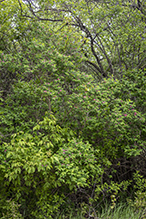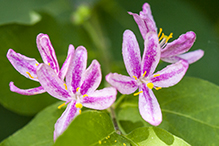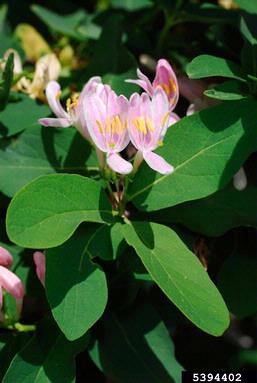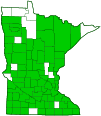Bell’s honeysuckle
(Lonicera × bella)
Conservation • Weed • Wetland • Description • Habitat • Ecology • Use • Distribution • Taxonomy
Description |
||
Bell’s honeysuckle is an erect, perennial shrub that rises on multiple stems from a shallow, spreading. fibrous root system. It can be from 5′ to 13′ tall, but is usually no more than 8′ in height. It often forms a rounded mound as wide as it is tall. It can create dense thickets. Stems are erect, ascending, or arching, and up to 2⅜″ in diameter at the base. Bark on older stems of young shrubs is thin, light brown to gray, and rough to the touch. It forms narrow, vertical strips that do not peel. On older shrubs the bark becomes shaggy and peels in narrow strips. Twigs are 1 ⁄32″ to 1 ⁄16″in diameter. The pith is brown and hollow. In the first year twigs are light green to reddish-green at first, and sparsely to densely covered with short, curved hairs, becoming brown and almost hairless as they age. In the second year they are brown to gray and hairless or almost hairless. Leaves are opposite on hairy, 1 ⁄16″ to ¼″ long leaf stalks. The leaf blades are usually oblong or oblong egg-shaped, sometimes egg-shaped, ⅝″ to 2 3 ⁄16″long, and 5 ⁄16″to 1″ wide. They are broadly angled or rounded at the base, and usually angled to a bluntly or sharply pointed tip. The upper and surfaces are not covered with a waxy bloom (glaucous). The upper surface is dark green and sparsely hairy or almost hairless. The lower surface is pale green and sparsely to moderately covered with fine, curved hairs, at least along the main veins. The margins are untoothed and hairy with usually curved, sometimes straight hairs. The ultimate inflorescence unit is a pair of unstalked flowers at the end of a single inflorescence stalk (peduncle) rising from a leaf axil of a current year branchlet. The peduncle is light green or light reddish-green, sparsely hairy to almost hairless, and 5 ⁄16″ to ¾″ long. There is a pair of modified leaves (bracts) at the base of each peduncle and a pair of secondary bracts (bractlets) at the base of each flower. The bracts are linear hairless or sparsely hairy, and 1 ⁄16″ to 3 ⁄16″ long, about the same length or slightly longer than the ovary. The bractlets are oblong to egg-shaped and 1 ⁄32″ to 1 ⁄16″long, about ½ to ⅔ as long as the ovary. The flowers are ¾″ to 1″ wide. There are 5 sepals, 5 petals, 5 stamens, and 1 style. The sepals are green and hairless or hairy. They are fused together into a calyx tube that is fused to and completely covers the ovary, and are split at the tip into five 1 ⁄32″ to 1 ⁄16″long lobes. The petals are ½″ to ⅞″ long and white to pink, rarely all white. They are fused at the base into a narrow corolla tube then separated ½ to ⅔ of the way to the base into 5 narrow, inversely lance-shaped, more or less spreading lobes. The tube is noticeably swollen at the base. The lobes equal in length and are bilaterally symmetrical, with two upper lobes, two lateral lobes, and a lower lobe. The corolla may fade to yellow as it ages. The stamens have white to pinkish filaments and yellow anthers. The style is hairy. The stamens and style are shorter than or about as long as the corolla lobes and project well beyond the corolla tube. On at least one of the cultivated hybrids (see Comments below) the upper two corolla lobes are fused together appearing as one lobe that may be notched at the tip. The fruit is an orangish-red to red, ¼″ to 5 ⁄16″ in diameter, more or less spherical berry containing 2 to 6 seeds. It reaches maturity from mid-June to mid-July. |
||
Height |
||
5′ to 13′ |
||
Flower Color |
||
Pink to white |
||
Habitat |
||
Open woodlands, thickets, grasslands, streambanks, railroads, and roadsides. |
||
Ecology |
||
Early mid-May to early June |
||
Pests and Diseases |
||
Honeysuckle aphid (Hyadaphis tataricae) causes a witches’ broom of stunted leaf and stem growth at the end of shoots. |
||
Defense Mechanisms |
||
Bell’s honeysuckle leafs out early in the spring, shading the ground and inhibiting the growth of native species. Left unchecked, it can grow large, crowding other plants and using available soil moisture and nurtients. It may also release a chemical into the soil that further inhibits the growth of other species (alelopathic). |
||
Use |
||
|
||
Distribution |
||||
|
Sources |
|||
| 2/19/2023 | ||||
Nativity |
||||
Horticulturally cultivated ornamental, fertile hybrid. Widely planted. Escaped cultivation. Naturalized. |
||||
Occurrence |
||||
Very common According to Minnesota State Botanist Welby Smith, Bell’s honeysuckle is “more common in the wild than either parent.” |
||||
Taxonomy |
|||
| Kingdom | Plantae (Plants) | ||
| Division | Tracheophyta (Vascular Plants) | ||
| Subdivision | Spermatophytina (Seed Plants) | ||
| Class | Magnoliopsida (Dicots) | ||
| Subclass | Caryophyllidae | ||
Order |
Dipsacales (honeysuckles, moschatels, and allies) | ||
Family |
Caprifoliaceae (honeysuckle) | ||
| Subfamily | Caprifolioideae | ||
Genus |
Lonicera (honeysuckles) | ||
| Subgenus | Lonicera | ||
| Section | Lonicera | ||
Bell’s honeysuckle represents several genetically distinct fertile hybrids of European cultivars of Morrow’s honeysuckle and Tatarian honeysuckle. |
|||
Subordinate Taxa |
|||
|
|||
Synonyms |
|||
Lonicera × bella f. albida Lonicera bella |
|||
Common Names |
|||
Bell’s honeysuckle bella honeysuckle showy fly honeysuckle showy honeysuckle whitebell honeysuckle |
|||
The common name, Bell’s honeysuckle, suggests that the plant is named after a person whose last name is Bell. If that were the case, the scientific species name would be belli or bellii. The actual name, bella, means “beautiful” or “showy” in Latin. The common name should then be bell honeysuckle, with a lowercase b and without the apostrophe and s. Showy honeysuckle may be a more appropriate name for this shrub, and a few authorities use that name. |
|||
Glossary
Allelopathy
The release of a chemical toxin by one plant to inhibit the growth or germination of nearby competing plants.
Axil
The upper angle where the leaf stalk meets the stem.
Bract
Modified leaf at the base of a flower stalk, flower cluster, or inflorescence.
Bractlet
A small, often secondary bract within an inflorescence; a bract that is borne on a petiole instead of subtending it; bracteole.
Calyx
The group of outer floral leaves (sepals) below the petals, occasionally forming a tube.
Corolla
A collective name for all of the petals of a flower.
Filament
On plants: The thread-like stalk of a stamen which supports the anther. On Lepidoptera: One of a pair of long, thin, fleshy extensions extending from the thorax, and sometimes also from the abdomen, of a caterpillar.
Glaucous
Pale green or bluish gray due to a whitish, powdery or waxy film, as on a plum or a grape.
Peduncle
In angiosperms, the stalk of a single flower or a flower cluster; in club mosses, the stalk of a strobilus or a group of strobili.
Pith
The spongy cells in the center of the stem.
Sepal
An outer floral leaf, usually green but sometimes colored, at the base of a flower.
Visitor Photos |
|||||
Share your photo of this plant. |
|||||
| This button not working for you? Simply email us at info@MinnesotaSeasons.com. Attach one or more photos and, if you like, a caption. |
|||||
|
|||||
MinnesotaSeasons.com Photos |
|||||
Plant |
|||||
 |
|||||
Flowers |
|||||
 |
 |
||||
Buds |
|||||
 |
|||||

Slideshows |
||
| Bell's Honeysuckle Vermont Invasives |
||

|
||
| Bells Honeysuckle Traviss5544 |
||
About
Published on Nov 5, 2013 |
||

Visitor Videos |
|||
Share your video of this plant. |
|||
| This button not working for you? Simply email us at info@MinnesotaSeasons.com. Attach a video, a YouTube link, or a cloud storage link. |
|||
Other Videos |
|||

Visitor Sightings |
|||||
Report a sighting of this plant. |
|||||
| This button not working for you? Simply email us at info@MinnesotaSeasons.com. Be sure to include a location. |
|||||
|
|||||
MinnesotaSeasons.com Sightings |
|||||
Avon Hills Forest SNA, North Unit Bertram Chain of Lakes Regional Park Carpenter St. Croix Valley Nature Center Carver Highlands WMA, South Unit Kellogg Weaver Dunes SNA, Kellogg Weaver Unit Lake Alexander Woods SNA, South Unit Robert Ney Memorial Park Reserve |
|||||

|
Created: Last Updated: © MinnesotaSeasons.com. All rights reserved. |
